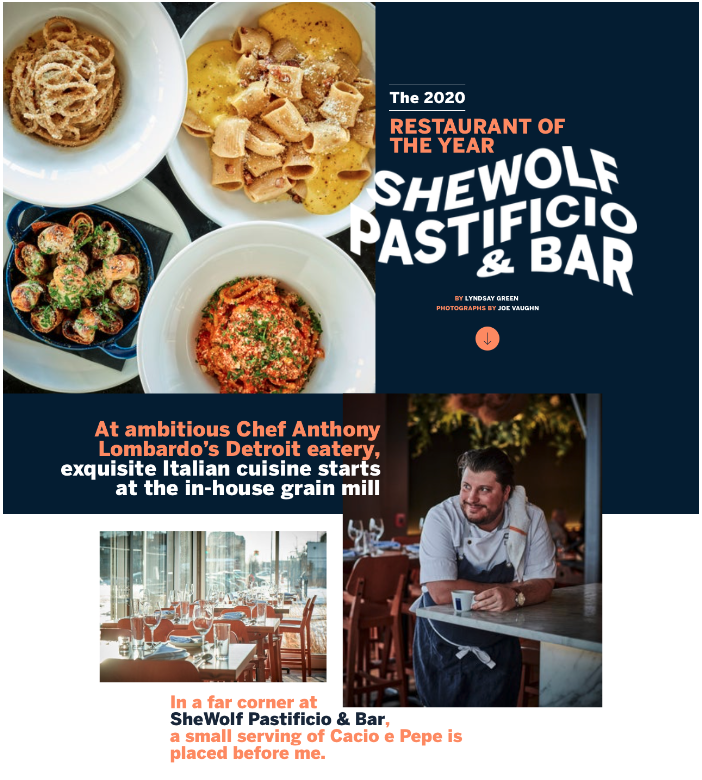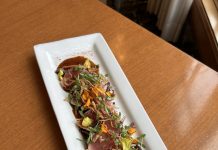
I’m typically partial to pasta dishes with more complex flavors — a medley of shellfish swimming in a sea of a tomato-based broth and linguine, or, if I’m at home, lasagna rolls whose wide noodles are merely a vehicle for layers of cheese and hot Italian sausage. But I’ve been here before; at SheWolf, you let the pasta shine.
A simple bird’s nest of tonnarelli sits in a puddle of a silky bisque, which lends the slip needed to swiftly twirl the al dente noodles around my fork and slurp the longer pieces, splashing the tip of my nose with the delicate sauce. Crumbles of buttery Pecorino and mildly spicy cracked black peppercorn flakes lin- ger on my lips for just a moment before I dab them with the pale blue cloth napkinette draped across my knee. The classic dish is both modest and rich, a case study in the colossal value of cooking with only the freshest ingredients.
are two refreshing beverages on SheWolf’s drink menu.
The star of the pasta program at SheWolf, Executive Chef Anthony Lombardo’s love letter to Roman cuisine, is no secret. In fact, it’s on full display in the restaurant’s contemporary din- ing room. To fully appreciate the chewy, earthy, often artisanal noodles plated at SheWolf, you’ll want a lesson in the impressive milling process, which occurs in the pastificio, Italian for pasta factory. Venture through rows of marble tables topped with singular white ceramic vases filled with short wheat stalks. You’ll pass by the glossy leather banquettes with oversized hammered-nail details that line one wall. Another is lined with nearly 200 wine bottles encased in glass. On a busy evening, as most evenings are, you’ll need to be cautious not to bump into the crowd of diners at the central bar that anchors the restau- rant. There, housemade syrups intended for craft cocktails top the bar, and bottles of Aperol stand in formation for the classic Italian spritz.
It won’t be long before you reach the pastificio at the far left corner of the open kitchen. Glass encases a space lined with white, square-tiled walls, giving diners a clear view of industrial machinery and, at any given moment, chefs at work. In this room, pasta cooks resemble chemists, their white coats evocative of lab coats. In this room, they’re milling heirloom and heritage grains to create SheWolf’s pasta flour daily. It’s also where they roll, extrude, and weave each of the nine pasta varieties on the restaurant’s menu — as well as the four or five off-menu options available at any given time.
When SheWolf opened its doors in the summer of 2018, Lombardo and his team, which includes chef di cucina Mark Camaj (Lombardo’s childhood friend, whom he considers a brother), were milling nearly 50% of the pasta flour used to create such noodles as the hearty tonnarelli featured in the humble Cacio e Pepe. Today, they’re milling 100% of the flour, not just for their pasta, but for the restaurant’s breads and polenta as well. “We’ve evolved our whole milling program,” Lombardo says. “It’s a trend that I took on — you don’t even see it that much in Italy — but it’s something that I was very curious about and did a lot of research on. You can definitely taste the difference.”
Today, they’re milling 100% of the flour, not just for their pasta, but for the restaurant’s breads and polenta as well.
You can taste the difference. A waft of rosemary perfume approaches the table a split second before the plate of warm, fresh Lombardia focaccia arrives. Four thick slices with a crispy crust and fluffy inside are salted to perfection. A dollop of creamy Gorgonzola is presented with a hollowed center, creating a small well for a pool of verdant olive oil. It’s unclear whether it’s the warmth from the oil or the heat from the bread that begins to melt the Gorgonzola dolce. What is clear is that the sight of the drippy cheese gliding across the wooden plank it’s presented on is glorious.
Under Contorni di Verdure, the menu’s slot for a rotation of vegetables and sides, organic Michigan-grown corn is milled into a creamy polenta. A savory cauliflower sugo is ladled over the porridge and topped with buttery pine nuts for a soft crunch.
Lombardo credits SheWolf’s miller and pastaio (Italian for pasta maker), Seth High, for the team’s ability to mill 100% of the flour and cornmeal used in each dish. Like a swift game of hot potato, High, the tall, good-humored gent who spends the most time in the pastificio-cum-chemistry lab, tosses the adulation back to Lombardo. “It’s not about me,” High says. “He’s the guy in front of this all.”
Lombardo was raised in Sterling Heights. Yet the SheWolf chef, who was born to Italian parents — his mother from Abruzzo, his father Sicilian — says he wanted to create a con- temporary Italian restaurant befitting any city in Italy. “People think they know Italian food, but they really don’t, so we do a lot of education with the staff. For example, making sure the servers are saying ‘Parmigiano’ and not ‘Parmesan.’ Parme- san is a word that the Kraft [Foods] corporation trademarked, and it just means grated cow’s milk cheese. We use Parmigiano-Reggiano, which is the king of cheeses and the cheese of kings.” In addition to language lessons, Lombardo implements regional Italian cooking classes with servers, whom he sees as the “salespeople” of the dining room.
“Pasta is always an individual course in Italy. You’ll never see it with chicken on top.”
–Anthony Lombardo
Lombardo also seeks to modify the way American diners interpret Italian cuisine, dispelling common misconceptions that all Mediterranean dishes are dredged in garlic and tomatoes — “We don’t use that many tomatoes; especially in the winter,” he says — and that portions are massive. “Our biggest challenge was that people wanted larger portions, but portions are much smaller in Italy.” Is it Italian tradition to serve slices of meat or fish atop a bed of pasta? Or to order an entrée with a side of pasta, as one sometimes does at family-style Italian- American joints that will not be named? These are questions better suited to Lombardo, who offers a resounding “no.” “Pasta is always an individual course in Italy,” he says. “You’ll never see it with chicken on top.”

Thus, you won’t see such a construction at SheWolf. Here, the Nidi di Rondine, a dish Lombardo considers among the standout pastas, features flat noodles layered with an herbaceous black truffle mushroom and sausage ragu, and rolled into chewy coils bursting with flavor. No tomato sauces or sides needed, just a dusting of Taleggio and a sprinkle of fresh herbs for garnish.
Lombardo’s aesthetic of minimalistic dishes — simple, yet so filling and well-balanced that at no point do you long for more sauce or yearn for seconds — can in part be attributed to the influence of a local Italian cuisine goliath. Between 2005 and 2009, Lombardo was under the tutelage of one of the most for- midable chefs in town, Luciano DelSignore, executive chef at Bacco and Pernoi. Lombardo cut his teeth at Bacco, where he honed his greatest skill: keeping it simple.
“When you’re a young chef, you try to do so much,” he says. “Luciano really reined me in and made me a little more focused on simplicity. He also taught me how to run a restaurant prop- erly.” Lombardo would go on to helm 1789 and The Hamilton, two well-regarded establishments in the nation’s capital, both of which would rack up numerous awards under his leadership.
Lombardo was under the tutelage of one of the most formidable chefs in town, Luciano DelSignore, executive chef at Bacco and Pernoi.
Lombardo’s work is lauded by culinarians who recognize a chef’s pristine attention to detail, kitchen skills, and dedication to quality service, as evidenced by his nod in the semifinals of the 2019 James Beard Foundation Awards. Lombardo was up for the award for Best Chef: Great Lakes, a distinct honor for a Midwestern chef. The award ultimately went to Beverly Kim and Johnny Clark of Parachute in Chicago, but the recognition of Lombardo was noticed across the state.
Lombardo’s use of farm-sourced fruits and vegetables culled from mostly local pastures is further indication of his commitment to serving fresh ingredients at every turn.
“As we’ve grown, we’ve developed relationships with new farms and different purveyors, and it’s really elevated our pan- try and the amount of ingredients that we can get,” Lombardo says. “That makes us more creative and allows us to change our menu more.” One farm that SheWolf has developed strong ties with is Cold Frame Farm in Romeo. “We had them plant vegetables for us in the winter, and we’re starting to see the fruit of that labor now.”
Those fruits, in the literal sense, appear in various elements across SheWolf’s menu. Georgia citrus rounds and Florida orange slices create a sweet, juicy base for the Citrus salad, a delight of color and zest. Apicius spice and olives add tang and a subtle heat for depth, and nearly sheer ribbons of fennel slink throughout like jellyfish tentacles, an artful presentation almost too handsome to dissect. Almost.

Meanwhile, spheres of crisp apples and sticky raisins round out a plate of Capesante. Grilled scallops are meticulously charred, their smoky-sweet flavor complemented by a heavenly brown butter celery root puree.
For dessert, at Lombardo’s suggestion, I try the Cioccolato, a chocolate ganache dish where each element is delicious on its own yet magnified when indulged all at once. Airy whipped cream is drizzled with olive oil and sprinkled with sea salt flakes for a sweet and savory mouthful. Toasty hazelnuts, a dense chocolate pie crust, and a peanut brittle blade add crunch. And the velvety ganache, paired with a gritty caramel base, offers a smooth finish.
Like the rest of the menu, Lombardo’s desserts are both mini- mal and sublimely decadent, precisely the combination that earned SheWolf its title as Hour Detroit’s 2020 Restaurant of the Year.
Like the rest of the menu, Lombardo’s desserts are both minimal and sublimely decadent, precisely the combination that earned SheWolf its title as Hour Detroit’s 2020 Restaurant of the Year.
|
|
|
















